Prairie Train
All Aboooooard!
During the first half of the twentieth century, the legendary steam engines of the Great Northern Railroad ruled the American northwest from Seattle, Washington, to St. Paul, Minnesota. Riding the Empire Builder was the safest, fastest, and most comfortable way to travel, as it chugged over wide rivers, across the Great Plains, and through snowbound mountain passes with such regularity you could set your watch by it.
But for a small girl travelling by herself for the first time, a trip from her country home to visit Grandma in the city of St.Paul is anything but routine. With words rich in the rhythm of the rails and paintings both beautiful and authentic, Prairie Train welcomes you aboard the Great Northern for a memorable journey across the country and into the past. Prairie Train was inspired by Ms. Chall’s own childhood train travel and by a bit of family history. Her grandmother was once stranded on a train for three days in a blizzard en route to visit her granddaughter.
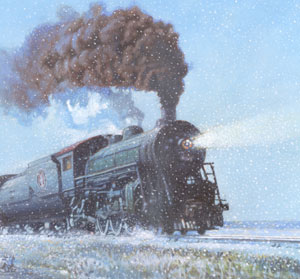
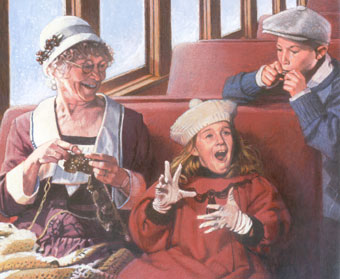
John Thompson did a wonderful job illustrating my manuscript in a photorealistic style. Some of his paintings are so vivid that the characters nearly jump out of the book! He is a professor of illustration at Syracuse University.
His first children’s book was Christmas in the Big House, Christmas in the Quarters by Patricia C. McKissack and Fredrick L. McKissack. That book received many awards, including the Coretta Scott King Award. Mr. Thompson has also illustrated O Jerusalem: Voices of a Sacred City, written by Jane Yolen, and Freedom Like Sunlight, written by J. Patrick Lewis.
Resources
- Have each student make a train car out of colored paper. Be sure to put in windows so the passengers can see the scenery as they pass by! Write some of the descriptive words that were used in the story.
- Form a train by standing in a line. Move bent arms in time and take short steps. The student who is the engine can make the “Choo! Choo!” sound and the rest of the train can do the “chug-a-chug‑a.”
- Read some other train books such as: Steam, Smoke, and Steel by Patrick O’Brien or Seymour Simon’s Book of Trains.
- Take a look at some black-and-white pictures of Great Northern Trains at the Great Northern Archives. The train in the book was called “The Empire Builder.”
Thanks to Kathy Johnson, media specialist in Alexandria, Minnesota, for these suggestions.
Hearing from Fans
Sometimes fans send photos. I’m honored that this family re-created the protagonist from Prairie Train with such painstaking detail.
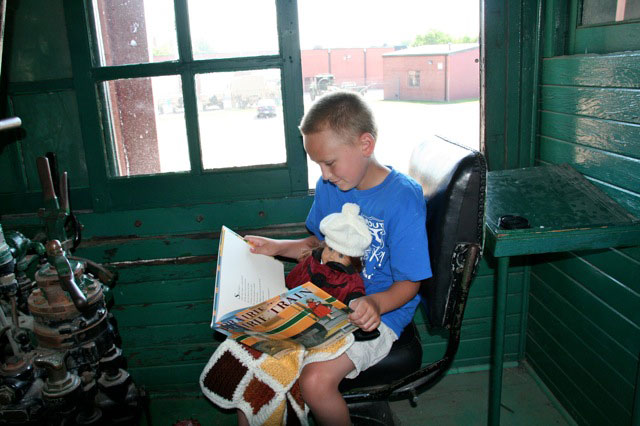
Kathy wrote: Stirling and his doll, Emily, on the locomotive at the Kandiyohi Museum. My mom spent months making things and getting other people to make things so she could assemble an entire Prairie Train outfit for Emily. We visited the Great Northern 2523 at the museum on our way home from vacation.
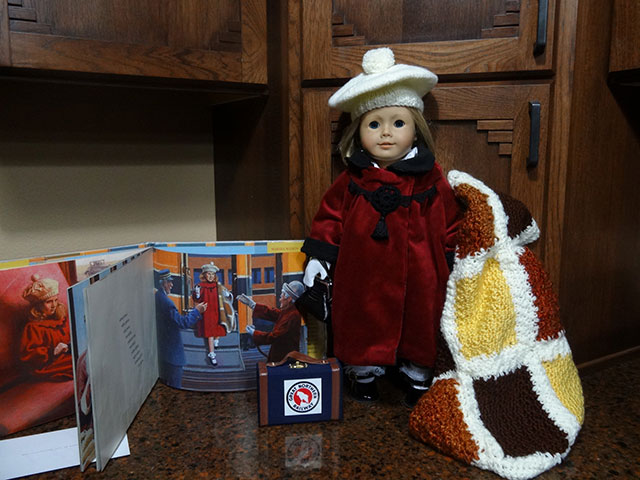
My mom’s Kit doll modeling Emily’s clothes
Reviews
For a girl riding the rails across the 1930s American prairie, the journey is suffused with sounds: the train whistle’s “woooOOOO!,” the “Shooh… Shooh…” that indicate the pants and huffs and puffs” of the engine’s steam, the “clickety click click click” of a passenger’s knitting needles “keeping time with the Great Northern line.” Chall (Happy Birthday, America!) harnesses these melodies, building a locomotive rhythm into her prose (“heading far away from home—/ shined shoes,/ white gloves,’ coin purse,/ two dollars,/ cranberry coat,/ wool beret—/ Grandma’s girl,/ city queen). As the girl narrator travels east, young readers with a passion for the past will thrill to ride alongside her, experiencing the train’s elegant dining car and velvet seats “as soft as caterpillars,” and gazing out at the prairie, “stitched together in brown and yellow patches,” flying by. Thompson’s (Christmas in the Big House, Christmas in the Quarters) saturated, photo-realistic paintings make the period details vivid enough for readers to feel they could step into the narrator’s world. In many pictures Thompson depicts the girl in mid-action (tumbling off a seat when the train stops; singing with hands spread), which enhances the immediacy of the artwork. This handsome volume lyrically evokes a bygone world (Publishers Weekly)
Marsha Wilson Chall, who has written feelingly about old-time maple-sugaring and small-town Fourths of July in Minnesota, tells in Prairie Train a story from 1924 of a girl’s first solo train trip across the prairie on the Great Northern Railway’s Oriental Limited to visit her grandmother in St. Paul. Chall is unusually sensitive to the heightened awareness, the wonder mixed with fear, that travel brings with it, especially when all that’s familiar seems to be receding as rapidly as the girl’s smiling, waving mother back on the station platform.
As the girl—we never learn her name or age, though she looks about 9—sinks into her seat, “on cushions as soft as caterpillars,” she slowsly extends her senses into the elegant new world around her “here on the Great Northern,” noticing how “the sun breaks into pieces on a rose-garden carpet” and glints off “brass fittings polished to gold.” Reassured, she looks outside at the endless prairie “stitched together in brown and yellow patches, like Grandma’s quilt spread over the hills.”
At first the Oriental Limited, one of the great trains of its day, seems almost unfaultable, a benevolent, orderly presence within the vast otherness just beyond. The girl can safely experiment with away-from-home behavior, ordering “just what I like” in the dining car and slyly slipping five sugar cubes from the sugar bowl into her coin purse without retribution from the kindly waiter.
But then, unexpectedly, the train lurches to a halt, stopped by a snowdrift on the tracks. “Without warning, the Great Northern is as quiet as a frozen buffalo, and after a while the cold sneaks in.” In these suddenly scarier circumstances, the passengers rally round; the woman across the way teaches the girl how to knit; “a tall boy wearing a tie” gets them all to singing “Oh! Susanna” and “The Ballad of Casey Jones.” Before too long a “snowplow engine is tunneling through,” and all is well again.
John Thompson’s vibrant, meticulous illustrations capture both the simple events and the grand scale of the girl’s adventure, using heraldic swaths of bright color to blazon forth both her autumn-leaf red coat, white tam‑o’-shanter and black patent leather shoes and the train’s gaudy paint scheme of Omaha orange, Pullman green and gold stripes (The New York Times Book Review)
A young girl relays the thrill of her first train ride as she takes the Great Northern across the prairie to visit her grandmother in Saint Paul. Graceful phrasing (“Night chases close behind [the train] and hitches a rail”) and word placement on the pages generate the rhythm of the journey, which is accentuated by train sounds that appear in italics. The colorful acrylic illustrations create both atmosphere and emotions as the girl delights in choosing her favorites in the dining car, sings along with a boy playing the harmonica when a snowdrift stalls the train, and worries whether her grandmother will be waiting for her … [T]his is a poignant glimpse of a time gone by (possibly the 1920s or 1930s), which shares a special experience. (Booklist)
As the Great Northern chugs its way to St. Paul, past fields “stitched together / in brown and yellow patches, / like Grandma’s quilt spread over the hills,” a lone child in her Sunday Best gazes happily out the windows, takes a meal in the dining car (surreptitiously dropping sugar cubes into her wallet as mementos), makes friends with those seated around her when the train is temporarily halted by a snowdrift, then steps off at last, and into her grandmother’s arms. Thompson places the ride in the 1920s or ’30s, depicting passengers and elegant interiors with photorealistic sharpness, then backing off to show the big train steaming its way through towns and over rolling prairie. Despite occasional anxious moments, the generally buoyant tone of this individual odyssey will reassure prospective young travelers, and trainiacs will pore over the period details. (Kirkus Reviews)
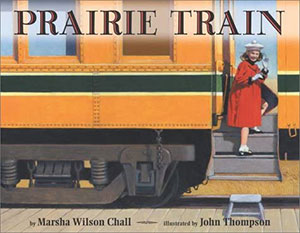
illustrator, John Thompson
HarperCollins, 2003
ISBN 978–0‑68813–4334
ages 4 and up
32 pages
Look for this book at your favorite library or used bookseller.
